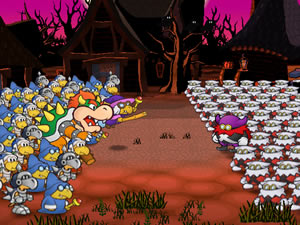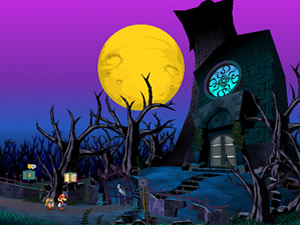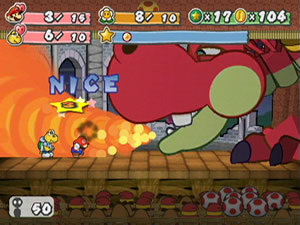Following the fold.
Why is Mario always searching for celestial doodads? If the little goober isn’t
trying to collect stars, he’s
trying to find pieces of the sun and moon. I think in his next game, Mario
should just search for the seven mystical meatballs to create the perfect meatball
sandwich.
But while it’s-a spicy fun to point out gaming mainstays like Mario’s astrological
kick, it’s far more entertaining to finally play a Mario game wholly aware of
its clichés
and ready to make fun of itself. Paper Mario: The Thousand
Year Door does exactly
that, a much needed reflective bonk on the head for the Mario series and a pretty
darn good RPG to boot.
At first, The Thousand Year Door retreads the original Paper
Mario. Nintendo-land (or whatever it’s called) is thrown into a tizzy when
Princess Peach is abducted while on vacation. Mario catches wind of the matter
and, using a handy map, sets off to restore order by collecting seven magic
stars. They should really start paying him for this kind of work.
If you are patient, the game starts throwing some pretty sweet curveballs. Sure,
Mario is still saving the Princess and eating mushrooms, but more so than any
previous Mario RPG, The
Thousand Year Door really knows how to have fun with the story. You’ll
watch the usual suspects like Luigi and Bowser go through their everyday lives,
acting strange and funny and entertaining you thoroughly the whole time. The
game’s progression even manages to stay interesting despite its traditional approach.
While The
Thousand Year Door is divided into typical chapters, you aren’t
always in the same village-to-castle-to-dungeon loop. Instead, you might find
yourself in a full on Battle Royale fighting championship. Another chapter takes
you to a Twilight World, where the environments resemble something out of Viewtiful
Joe. The creativity and variety is commendable.
In between these chapters are small interludes during which you discover the goings-on with the other main characters, such as the world conquering X-naught aliens, Princess Peach, and Bowser. The best part of the first Super
Mario RPG was having Bowser along for the ride. This time, though, the game goes so far as to throw in some Super
Mario Brothers side scrolling action…starring Bowser himself! It’s a total mindscrew to see a gigantic Bowser run from left to right, stomping on Goombas, and illustrates the game’s sense of humor.
Mario himself has plenty of stomping to do. Visible on-screen enemies are avoidable,
removing the pain of random battles that plague too many RPGs. Instead, enemies
will slowly waggle towards you, and if you properly time a stomp or a hammer
smash, you can get the leg up on the turn-based combat. The battle
system continues the same finely tuned, hubris free system of Paper
Mario.
Instead of fighting off a 999999 HP beast like in every other RPG under the
sun, the numbers you deal with in Paper Mario are small and manageable. Hop
on an enemy, knock off 1 point. One. Uno! That’s
it! In turn, there are clear and intuitive solutions for every confrontation
rather than making you just launch the kitchen sink at every bad guy.
 Like before, you can affect the damage given and taken by timed button presses.
Like before, you can affect the damage given and taken by timed button presses.
Nail it when you strike for added damage, or nail it when attacked to halve
or even nullify damage entirely. This gives an added layer of depth to what
can be a somewhat repetitive combat system.
In an interesting design twist, combat plays out on a stage, of sorts, complete
with an audience. Play well and you can recoup your Special meter faster via
audience applause. If you properly work the system, you can keep the Special
meter active through long stretches of battles, such as a 100 room dungeon
challenge. The crowd will even toss out items from time to time or pelt our
hero with trash should he stink it up too much.
Throughout his adventure, Mario gains the help of various buddies, like a pony-tailed
Goomba named, obviously, Goombella, a Koopa Troopa and a former chubby, diva
ghost with oddly disturbing ghost breasts. Most of these buddies parallel those
in the first Paper
Mario. Gombella can “tattletale” to reveal enemy abilities, while the
Koopa buddy can hurl his shell to retrieve objects.
As before, your party’s abilities can be improved through Badges, similar to
the Final
Fantasy VII Materia system. There’s a badge for every occasion, such as
spending less fire points for moves or healing before each turn. Finding the
multitude of hidden badges is part of the big quest and helps facilitate the
overall growth of Team Mario.
The “Paper” Mario concept is taken literally this time around, as Mario can
be folded into a paper airplane, a boat, or a tube to navigate past previously
insurmountable obstacles. In classic Nintendo game design, certain areas are
closed off until you progress far enough to learn some groovy new special ability.
It’s just a smartly designed game.
And quite a pretty one. The graphics reprise the combination 2D and 3D look of
the first Paper
Mario, but naturally, the storybook colors looks sharper and fresher
than on the N64. The visuals truly shine when the screen fills with hundreds
of hustling, bustling hand-drawn characters. Nintendo rarely puts out a shoddy
product and Paper
Mario is no exception, featuring a smooth framerate and few load times.
It’s
not always about high polygon count, you know.
 The sound is classic Nintendo fare with plenty of familiar tunes, but I still think it’s a bummer that these characters aren’t fleshed out with actual voices. This isn’t the era of silent movies. If there’s one Nintendo cliché that could be done away with, it’s the lack of voices. Paper
The sound is classic Nintendo fare with plenty of familiar tunes, but I still think it’s a bummer that these characters aren’t fleshed out with actual voices. This isn’t the era of silent movies. If there’s one Nintendo cliché that could be done away with, it’s the lack of voices. Paper
Mario does creatively use writing styles, font size, and text speed to create voice through visuals, but it’s high time to actually get some vocals out of Luigi, Bowser et al.
At its best, Paper Mario: The Thousand Year Door features smarter,
sharper writing than the other Mario role-playing games. Yet in spite of its
clever, tongue-in-cheek style, The
Thousand Year Door occasionally rests of its laurels and recalls the
first Paper
Mario too much. There isn’t much new ground broken in terms of its overall
gameplay. For instance, the game’s interactivity is underutilized. As Mario,
you’re running around with a giant hammer. Wouldn’t it be nice to be able to
hit an NPC and actually have it react? One of the mini-games revolves around
the Gamecube’s internal clock. Why not take a cue from Animal
Crossing‘s time-based world to create villages and environments that feature
functioning day/night cycles?
Despite its lack of serious innovation, Paper Mario: The
Thousand Year Door is another fun, high-quality RPG. Its humor, gameplay and delivery combine to create an excellent romp through familiar terrain. Fans of the original shouldn’t pass it up, and newbies will certainly want to take a peek behind the door.











